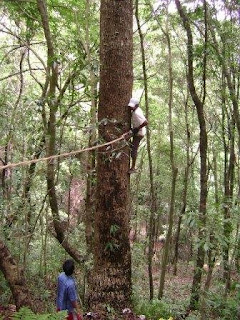In Kathmandu there are worse places to hang out than in Jana Bahā, majestic home to one of the Valley’s four famed Lokeśvaras. Like many icons of the Valley, it is sacred not only to Newar Buddhists, who control the ritual and institutional complex connected with the deity, but also for Tibetans (as Jo bo dzam gling dkar mo) and a sizeable number of non-Buddhists (in the guise of ‘White Matsyendranātha’).
 It so happens that tomorrow is an important day in the ongoing renovation of Jana Bahā. Formally this began with expeditions to the nearest forest (vanayātrā) to seek suitable lumber, much along the lines prescribed in Kuladatta’s Kriyāsaṃgraha (itself almost certainly a Newar composition). As almost the entire Valley has been deforested these days, the builders’ Getting of Wood took place on the mountains on the Valley’s rim. Nevertheless, chronicles record that timber was also scarce in the not-too-distant past; it would take several weeks or months to drag the chosen log(s) to their destination in the city.
It so happens that tomorrow is an important day in the ongoing renovation of Jana Bahā. Formally this began with expeditions to the nearest forest (vanayātrā) to seek suitable lumber, much along the lines prescribed in Kuladatta’s Kriyāsaṃgraha (itself almost certainly a Newar composition). As almost the entire Valley has been deforested these days, the builders’ Getting of Wood took place on the mountains on the Valley’s rim. Nevertheless, chronicles record that timber was also scarce in the not-too-distant past; it would take several weeks or months to drag the chosen log(s) to their destination in the city.
What makes this renovation qualitatively different from its many predecessors in the Newar tradition is a new level of transparency. The organizers have taken the startling but commendable step of documenting much of the process online, in English, at janabahaa.blogspot.com.


Dear J.J,
I love Jana Bahal.
I forgot the whole explanation, but don’t Tibetans just transcribe part of the Newar (?Jamali?) name of the image, as Dza-ma-li (not the Dzam-gling, which means Jambu Island, and might sound similar…)?
I don’t seem to have the necessary reference at hand.
Yours,
D.
Hi Ian,
Thank you for visiting our office the other day and making a cash donation to Janabahaa Society. We would love to meet you up when convenient to you (PDSZ said you are still in town) and exchange ideas and opinions. Please drop us a line at info@janabahaa.org.np when you have the time.
PS: We are wondering what Jinajik is.
Alok Tuladhar
for Janabahaa Society
Thanks for the question on the Tibetan name (there is more than one, I’m sure) of Janabahādyo. I need to check my Tibetan ‘sacred guides’ to the Valley, none of which I have scanned yet — the scanning wishlist happens to be still quite long.
The Sanskritic name of the deity, by the way, also happens to be less than clear. Just a couple of weeks ago I noticed that Siṃhanāda Lokeśvara, in his capacity as one of Nepal’s twelve Lokeśvaras, is supposed to be worshipped at Janabahā during the year-long program of vratas for these deities. Recently, manuscripts detailing the vrata procedures for each of these Lokeśvaras have come to light.
And, Mr. Tulādhar, I’ll be happy to drop by at the next opportunity.
Not to actually answer my own question, but I just looked in M. Slusser’s Nepal Mandala, p. 380, and there it seems there is supposed to be a very close connection between the White Matsyendra Lord and the Jamala village, so much so that the divine image is “often referred to as Jamaleśvara. Wouldn’t that somehow explain the Tibetan Dza-ma-li? (The Dzam-gling spelling also interests me greatly, since I love those types of ‘Tibetanizations’ in which foreign words or names are forced to make some kind of sense in Tibetan… I just recently noticed Legs-smin, ‘Well matured” as a Tibetanization of Laksminkara…). Cheers!